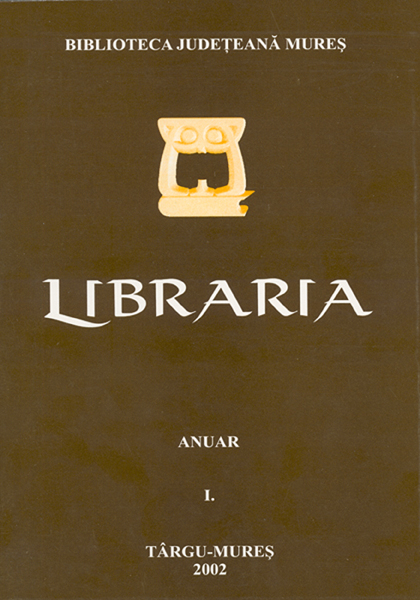Forţa iradiantă a cărţii vâlcene
The radiant force of the Vâlcea book
Book. Reading. Library.
Author(s): Dumitru LazărSubject(s): Library and Information Science, Other
Published by: Biblioteca Județeană Mureș
Keywords: Libraria; Biblioteca Județeană Mureș; biblioteconomie; bibliologie; carte veche; carte bibliofilă; istorie locală; servicii de bibliotecă; Biblioteca Teleki; carte veche românească;
Summary/Abstract: During centuries, Râmnic and other cultural centers from Vrancea, have been considered as a source of culture and romanian spirituality. The typographies from Cozia, Govora, Bistriţa, Hurezi and Râmnic are famous for their activity, for the books they have printed and all those books have created special conditions for the beginnings of the romanian religious literature. Short time after typography has been invented, the romanian voivodes became interested in endowing the churches and monasteries with books in order to assure, and increase, the acces to culture.In this way, there are some disagreements between Bistriţa and Dealu Monastery, concerning the priority about the first book printed on romanian land – Liturghierul lui Macarie (1508). On his efforts to solve the issue, P.P. Panaitescu supports the ideea of Bistriţa’s priority, that is probably because, during the 17th and 18th centuries, there was a famous school for copysts..Matei Basarab (1632-1654), a very educated voivode, has built the well-known monasteries from Arnota, Gura Motrului and Strehaia, and he laid the foundations of the typographies from Câmpulung and Govora, where a lot of religious and juridical works have been published. The most important one is Pravila Mică also known as Pravila de la Govora printed in 1640 and considered to be „the first romanian book of laws.”A century latter, during the reign of Constantin Brâncoveanu, at Hurezu Monastery a lot of famous books are printed, such as: Varlaam şi Ioasaf, Halima, Scara Sf. Ioan Scărarul, and some others books – O mie şi una de nopţi, Întrebări şi răspunsuri ale dumnealui Constantin Cantacuzino, fratele răposatului Şerban Cantacuzino – begun their diffusion.In the 18th century, one of the most interested person in romanian books diffusion was Antim Ivireanul; in 1705 he laid the foundations of a typography at Snagov; in this moment / century, Râmnic was considered to be the second romanian typography according to its activity. With him as a guide, almost 90 books have been printed, the most important being Tomul bucuriei and Antologhion.Some of the books printed at Râmnic during the 18th century – arround 1178 copies - can be found in 29 counties and 290 places.Arround 180 copies can be seen in Mureş county, according to the informations offered by Elena Mihu.The art of the typographs from Râmnic is not dissapearing; it was continuated by their disciples. In the first half of the 22th century there were 19 offices in Vâlcea county, that decided to follow and to practice this art of printing.
Journal: Libraria. Studii și cercetări de bibliologie
- Issue Year: I/2002
- Issue No: 1
- Page Range: 264-273
- Page Count: 10
- Language: Romanian

